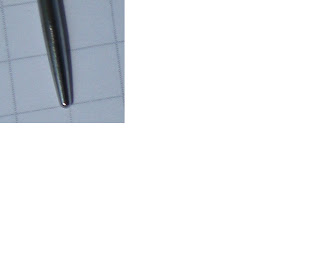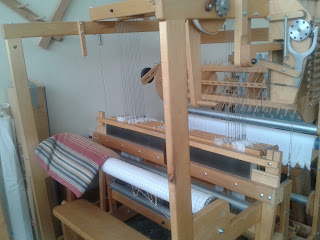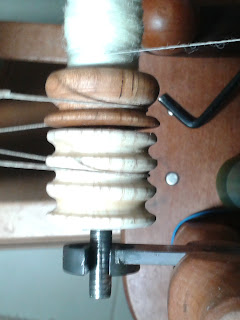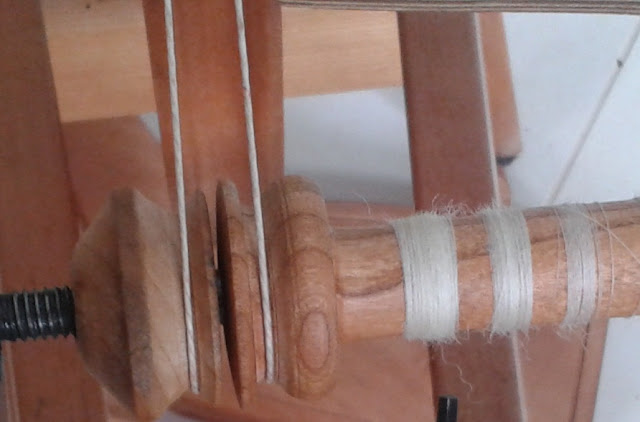QA/QC on a large order of steel gansey needles presented me with something of an existential crisis.
As I checked them, they were blunt, and as everyone knows, my needles are pointy, and I make the needles that I like to knit with. So how were these so blunt?
In the beginning, I made steel needles in the shape of all the commercial needles, and I polished them like jewelry. I felt that made the tips slippery, so I then left annular striations around the tip. That was better, the striation helped the working needle "grab" the yarn. In the last couple years, the striations have grated on my nerves and I have polished the tips more and more. As I did that, I made the needles less pointy, so the yarn would be less likely to fall off the taper.
Along the way I changed from poking the working needle into the next stitch to sliding the working needle along the other needle and into the next stitch. A by product of this is that the working needle was not pushed as far into the working stitch. These days I only push/slide the working needle about 4 mm into the working stitch.
A 2.5 mm Inox DPN has a 9 mm long taper. If you only push it in 4 mm into the working stitch, then the tip of the needle where one wraps the yarn is less than a millimeter in diameter. If you want to wrap the yarn around a full 2.5 mm needle then one must insert the Inox needle a full 14 mm into the stitch. These days, that is more needle motion that I want.
That means that I want the full diameter of the needle only a millimeter or two from the end of the needle. That means a very short taper. That means rather blunt needles. That is the end of the pointy needle.
The 2 needles at left in the knitting are my latest gansey needles. The 2 needles at center left are commercial 16" & 14" DPN. The single needle at center right is a striated pointy needle from the set that I used to make the Filey gansey 4 years ago. The 4 needles at right are a set of old English needles given to me by a student. They suggest that others knew that blunt needles do work if you have a knitting sheath and the right technique. The paper is 1/4" grid.
On the other hand, blunt needles are crap for picking up stitches. If you want to pick up stitches, you need pointy needles. Pointy needles are better for decreases and most lace stitches. Those ball tipped needles above are actually a bit too blunt for easy purling. If you are using a knitting technique (such as those derived from Weldon) where the needle is poked into the stitch, then pointy needles are better.
And, these observations only apply to metal needles of less than 2.5 mm.
Edited to add, the above suggests that I am selling those ball tipped needles. No, those are for my knitting garter stitch. These days the needle tips that I sell are more like:
As I checked them, they were blunt, and as everyone knows, my needles are pointy, and I make the needles that I like to knit with. So how were these so blunt?
In the beginning, I made steel needles in the shape of all the commercial needles, and I polished them like jewelry. I felt that made the tips slippery, so I then left annular striations around the tip. That was better, the striation helped the working needle "grab" the yarn. In the last couple years, the striations have grated on my nerves and I have polished the tips more and more. As I did that, I made the needles less pointy, so the yarn would be less likely to fall off the taper.
Along the way I changed from poking the working needle into the next stitch to sliding the working needle along the other needle and into the next stitch. A by product of this is that the working needle was not pushed as far into the working stitch. These days I only push/slide the working needle about 4 mm into the working stitch.
A 2.5 mm Inox DPN has a 9 mm long taper. If you only push it in 4 mm into the working stitch, then the tip of the needle where one wraps the yarn is less than a millimeter in diameter. If you want to wrap the yarn around a full 2.5 mm needle then one must insert the Inox needle a full 14 mm into the stitch. These days, that is more needle motion that I want.
That means that I want the full diameter of the needle only a millimeter or two from the end of the needle. That means a very short taper. That means rather blunt needles. That is the end of the pointy needle.
The 2 needles at left in the knitting are my latest gansey needles. The 2 needles at center left are commercial 16" & 14" DPN. The single needle at center right is a striated pointy needle from the set that I used to make the Filey gansey 4 years ago. The 4 needles at right are a set of old English needles given to me by a student. They suggest that others knew that blunt needles do work if you have a knitting sheath and the right technique. The paper is 1/4" grid.
On the other hand, blunt needles are crap for picking up stitches. If you want to pick up stitches, you need pointy needles. Pointy needles are better for decreases and most lace stitches. Those ball tipped needles above are actually a bit too blunt for easy purling. If you are using a knitting technique (such as those derived from Weldon) where the needle is poked into the stitch, then pointy needles are better.
And, these observations only apply to metal needles of less than 2.5 mm.
Edited to add, the above suggests that I am selling those ball tipped needles. No, those are for my knitting garter stitch. These days the needle tips that I sell are more like:




.jpg)